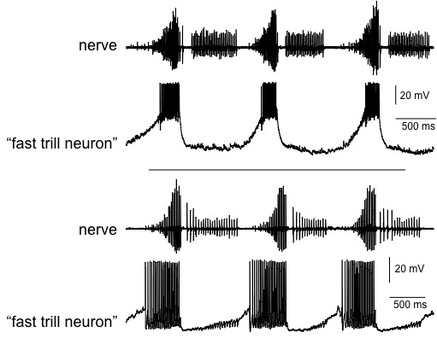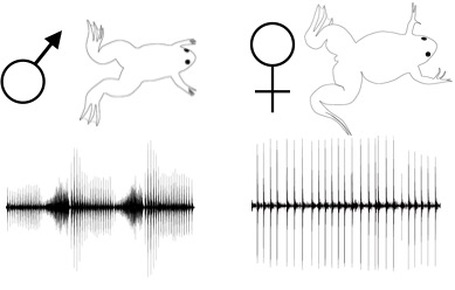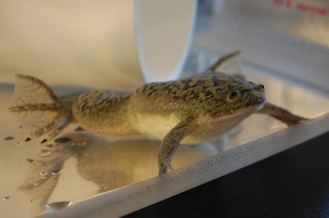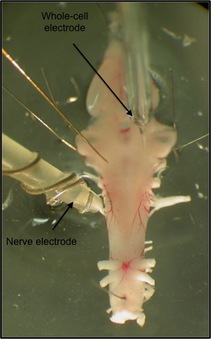Big picture
Our nervous system defines our experience. Without our neurons continually firing action potentials and releasing neurotransmitters, we would simply not be who we are. The importance of our brain to our lives cannot be overstated, nor can its dynamic complexity. In the Zornik Lab, we are investigating questions that attempt to uncover fundamental principles of nervous system organization, function, and modification. Because behaviors provide a quantifiable readout of neural function, we are investigating the neural basis of behaviors to accomplish this objective.
The lab is currently focused on two broad questions:
1. What are the neuronal and circuit properties that generate behavioral rhythms?
2. How do hormones modify cells and circuits to produce sex-specific behaviors?
The lab is currently focused on two broad questions:
1. What are the neuronal and circuit properties that generate behavioral rhythms?
2. How do hormones modify cells and circuits to produce sex-specific behaviors?
Research strategy: Central pattern generators (CPGs)
In order to understand how behaviors are generated and modified, we must be able to experimentally access the neural circuits that generate the behavior. Many researchers investigate special neuronal circuits called central pattern generators, or CPGs, to help understand the nervous system. The reason is straightforward: CPGs are discrete neural circuits that can generate behavioral rhythms without any rhythmic inputs. Imagine a music box that can play a certain song over and over again; the music is “built-in” to the system. Similarly, neuronal rhythms that produce behaviors can be “encoded” in networks of interconnected neurons called CPGs. Unlike music boxes, however, CPGs are dynamic entities, and variability in neuronal function and connectivity enable flexible behavioral repertoires. Our work investigates the CPG that generates vocal behaviors in the African clawed frog, Xenopus laevis.
Xenopus vocalizations
Vocal CPG
Functional identification of CPG neurons

Our approach to understanding the frog vocal system is to first identify vocal CPG neurons, and then determine the intrinsic properties and network connections between neuron classes that are critical to generating appropriate vocal patterns. We are particularly interested in identifying neuronal and network properties that enable neuronal rhythmicity and synchrony, universal features of all neural circuits.
By performing whole-cell patch-clamp recordings in the premotor region of the vocal CPG, we have identified a group of neurons that are only active during the fast trill portion of the male fictive vocalizations. In the examples on the left, you can see that the exact activation patterns of these "fast trill neurons" vary. In one (upper example), the cell undergoes a very large depolarization before it begins spiking after the onset of the fast trill. In the other (lower example), the cell undergoes a less dramatic depolarization during fast trills, but spikes through the entire trill. We continue to combine electrophysiology and pharmacology to discern how these and other functionally identified neuronal subtypes produce their distinctive activation patterns.
By performing whole-cell patch-clamp recordings in the premotor region of the vocal CPG, we have identified a group of neurons that are only active during the fast trill portion of the male fictive vocalizations. In the examples on the left, you can see that the exact activation patterns of these "fast trill neurons" vary. In one (upper example), the cell undergoes a very large depolarization before it begins spiking after the onset of the fast trill. In the other (lower example), the cell undergoes a less dramatic depolarization during fast trills, but spikes through the entire trill. We continue to combine electrophysiology and pharmacology to discern how these and other functionally identified neuronal subtypes produce their distinctive activation patterns.
Do motor neurons generate vocal rhythms?
In a canonical model of vertebrate motor systems, central pattern generators (CPGs) activate motor neurons that, in turn, activate muscles. In the Xenopus vocal circuit, however, we have strong evidence indicating motor neurons are required for generating behaviors. While this may be a unique attribute of an atypical circuit, another possibility is that the conventional wisdom regarding vertebrate CPGs is incomplete. We are using anatomy and electrophysiology to discover pathways by which motor neurons modulate the vocal CPG.
Hormonal regulation of the vocal CPG

Female and male frog brains (like humans) are strongly influenced by dynamic patterns of gonadal steroid hormones (such as estradiol and testosterone). We are particularly interested in the dynamic effects of androgens on both male and female brains. Xenopus laevis vocal behaviors are highly differentiated and remain strongly changeable in adulthood, but the neural properties that underlie these behavioral differences remain poorly described. We seek to identify ion channels, morphological specializations, and synaptic connections in the vocal circuit that are regulated by hormones. Such revelations should illustrate the molecular and cellular basis of sex-specific behavior.
While we primarily use electrophysiological and anatomical approaches to achieve our aims, we are beginning to incorporate additional techniques such as quantitative PCR, functional imaging, and transgenic modifications that are becoming increasingly feasible in the Xenopus species.
Funding

Research in the lab is currently funded by the National Institute of Neurological Disorders and Stroke at the NIH (NS091977). Previous funding has come from The Albert and Ellen Grass MBL Faculty Research Award of the Marine Biological Laboratory in Woods Hole, MA.
Proudly powered by Weebly



